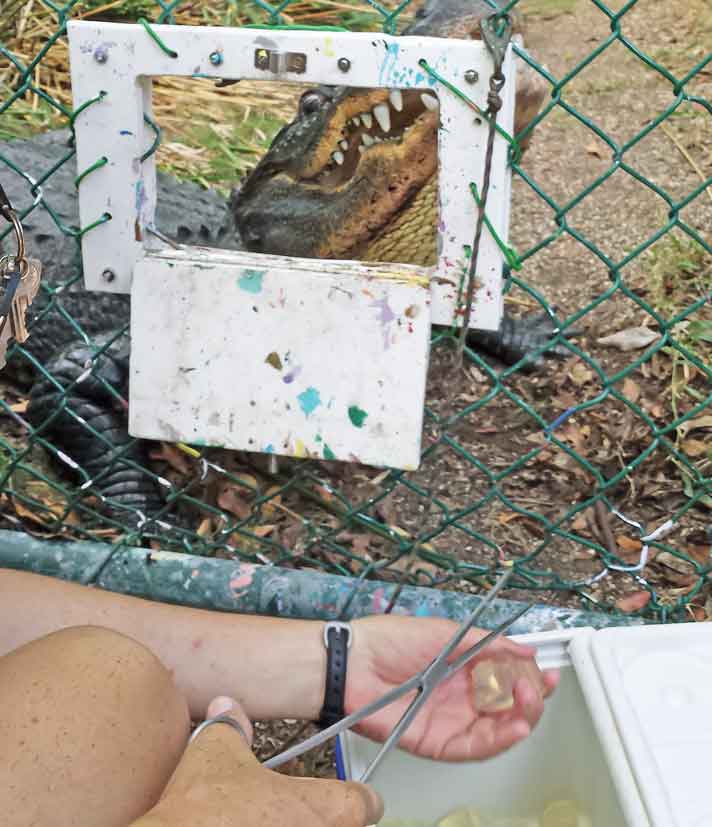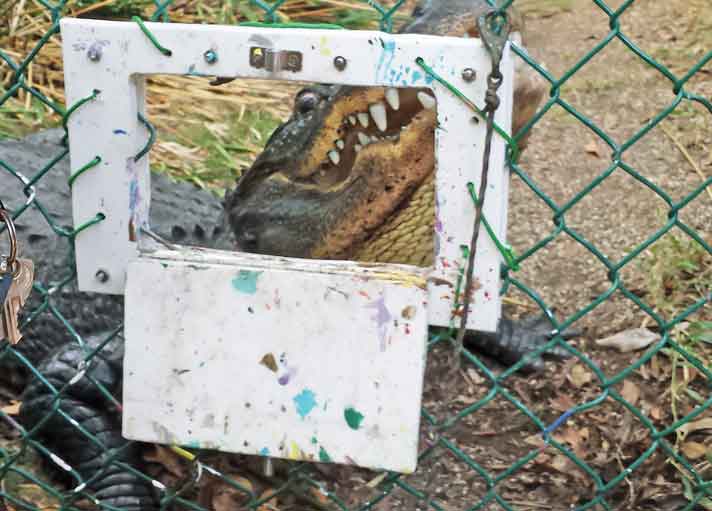Environmental enrichment will improve the health of captive reptiles.
For years, it has been standard practice to house reptiles in a minimalistic enclosure, with the thought being that the reptiles simply didn’t care. “Give a reptile a heat gradient, a light source and a place to hide” was the mantra in reptile husbandry. Keep it simple, right? Fortunately, this old-school train of thought is changing.

Courtesy Theater Of The Sea
This alligator has been trained to hold still for veterinary examinations by rewarding it with gelatin capsules (as seen in the person’s hand at the bottom).
Reptiles that can normally live for two or more decades under natural conditions often languish in captivity and die at an early age. This is because the diet, ambient temperature, relative humidity and lighting (wavelengths and photoperiods) provided to captive animals often do not parallel what the animal experiences in the wild. This lack of natural environmental essentials is sufficient to induce stress and ultimately weaken an animal’s natural immunity to disease.
In relatively recent times, these basic needs for a healthy life have risen to the forefront, and “environmental enrichment” is now a priority in captive environments. Environmental enrichment, which includes both appropriate physical husbandry management and psychological stimulation, provides the foundation for captive reptiles to display natural behaviors and exist in a (hopefully) stress-free situation. Included is the obvious necessity to provide natural terraria as well as mental stimulation, and an excellent way to provide the latter is to encourage natural behaviors.
Providing physical and mental enrichment has become standard practice at most professional facilities, and doing so should also be part of the private reptile keeper’s repertoire. Allowing captive animals the opportunity to make choices stimulates them mentally. No longer need they sit idle in one spot, waiting for something to happen. Instead, they should be given the opportunity to occasionally make things happen.
For instance, by hiding food items in various areas within a reptile’s enclosure—inside hide boxes, behind partitions and décor, beneath substrate, high up in branches, etc.—you can encourage foraging behavior. Giving the animal the ability to make an active effort to find the food will provide it with enrichment.
These behaviors obviously cannot take place in simple, box-type units such as the basic sweater box or shelf units commonly used when keeping reptiles. Although these units are efficient in regards to regular cleaning, maintenance and ease of access to the animls inside, they are environmentally and psychologically limiting.
Read More
The Association of Zoos and Aquariums (AZA) defines enrichment as,”a process for improving or enhancing animal environments and care within the context of their inhabitant’s behavioral biology and natural history. It is a dynamic process in which changes to structures and husbandry practices are made with the goal of increasing behavioral choices available to animals and drawing out their species-appropriate behaviors and abilities, thus enhancing animal welfare.” (AZA/Behavior Scientific Advisory Group, 1999).
Providing enrichment is not as difficult as one might think. The basis of successful enrichment is a fundamental understanding of the species’ natural biology. You must know where an animal lives, how it lives, what it eats, how it finds its food, what its normal diurnal/annual rhythms are, its natural aging process, its reproductive biology and more. This is not rocket science. In fact, in today’s ”knowledge at your fingertips” cyber world, this information is only a couple of mouse clicks away. In addition, numerous companies, including advertisers in REPTILES magazine, are now producing reptile care products that make providing these requirements relatively easy.
There are three fundamental goals to successful enrichment: 1) To promote natural, species-specific behavior; 2) to provide opportunities that will allow this natural behavior; and 3) to provide animals the ability to make choices
Reptile Behavioral Training as a Form of Enrichment
It has long been common practice for zoos to train their mammals to display specific behaviors, such as training a dolphin to present its tail for a routine blood collection, or an elephant to hold up its foot for a nail trim.
It was assumed that this type of training could not be utilized in reptiles. However, this assumption has been proven wrong, as many institutions have instigated target training for many reptile species. For instance, Komodo dragons have been trained to enter a crate for weighing and blood drawing, crocodiles are crate-trained to allow for similar engagements and ease of transport, etc. At one facility that I work with, the keepers have trained their alligators to present for physical examinations by using gelatin cubes as rewards. Such human-captive interactions are stimulating for the animals and provide constant enrichment.
Environmental enrichment will improve the health of captive reptiles, enhance their welfare, assist in facilitating their care and increase an owner’s awareness of the overall well-being of the pet.
Douglas R. MADER, MS, DVM, DABVP (C/F, R/A), DECZM (HERPETOLOGY), is a graduate of the University of California, Davis. He owns the Marathon Veterinary Hospital in the Conch Republic, and is a world-renowned lecturer, author and editor. He sits on the review boards of several scientific and veterinary journals.


